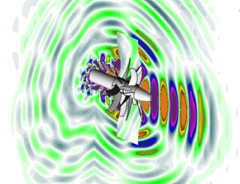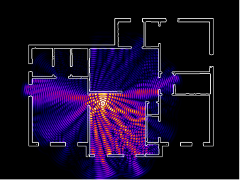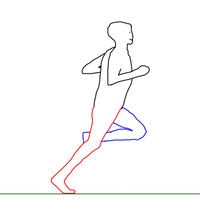Undergraduate Research Projects
Can a Computer Feel the Beat?
 The number of beats per minute in a music recording is relatively easy for a human with a watch to detect. However, computers find it much more difficult to automatically detect the speed of a music recording, and anecdotal evidence suggests most freely available algorithms are wrong at least 25% of the time! Uses for automatic beat detection include automatically seamlessly blending (mixing) from one song to another, and for use in sports such as running to choose music with a particular speed to run in time to. This project aims to investigate the feely available algorithms for detecting the number of beats per minute, and to assess their performance.
The number of beats per minute in a music recording is relatively easy for a human with a watch to detect. However, computers find it much more difficult to automatically detect the speed of a music recording, and anecdotal evidence suggests most freely available algorithms are wrong at least 25% of the time! Uses for automatic beat detection include automatically seamlessly blending (mixing) from one song to another, and for use in sports such as running to choose music with a particular speed to run in time to. This project aims to investigate the feely available algorithms for detecting the number of beats per minute, and to assess their performance.
The picture on the left is a beat graph, which is one way of visualizing the beats, bars, and sections of a music recording. The horizontal lines on the right of the plot show that the plot is correctly synchronized using the right number of beats per minute in this case.
Mathematical Modelling of Ring Rolling
 Ring rolling is an important industrial metal forming process. It is used to make parts for a variety of purposes, from oil platform legs to aircraft engine parts. Surprisingly little is known about the mechanics of ring rolling, and setting up a stable rolling process is largely done by informed trial and error. At present, only circular rings with a rectangular cross-section can be made. With recent interest in using computer control to make more diverse shapes with more exotic metals using less energy, simple quick-to-compute models of the process are needed. This project would use basic mathematical and computational techniques to derive a simple mechanical model for the basic ring rolling process.
Ring rolling is an important industrial metal forming process. It is used to make parts for a variety of purposes, from oil platform legs to aircraft engine parts. Surprisingly little is known about the mechanics of ring rolling, and setting up a stable rolling process is largely done by informed trial and error. At present, only circular rings with a rectangular cross-section can be made. With recent interest in using computer control to make more diverse shapes with more exotic metals using less energy, simple quick-to-compute models of the process are needed. This project would use basic mathematical and computational techniques to derive a simple mechanical model for the basic ring rolling process.
Theory of Summation By Parts Finite Differences
 Computational Aero-Acoustics (CAA) involves using computer simulations to model sound generated by and propagating through air flows. Applications range from hand driers and computer cooling fans to aircraft engines and wind turbines. These simulations push the limits of modern computers, and are (or should be) perfectly balanced between being too dissipative and being unstable. The simulations therefore rely on a significant body of mathematical theory. This project concerns recent developments in the theory of finite differences, commonly used in computational aero-acoustics simulations, and possible underlying theoretical links with finite elements.
Computational Aero-Acoustics (CAA) involves using computer simulations to model sound generated by and propagating through air flows. Applications range from hand driers and computer cooling fans to aircraft engines and wind turbines. These simulations push the limits of modern computers, and are (or should be) perfectly balanced between being too dissipative and being unstable. The simulations therefore rely on a significant body of mathematical theory. This project concerns recent developments in the theory of finite differences, commonly used in computational aero-acoustics simulations, and possible underlying theoretical links with finite elements.
Making Waves with Finite Differences
 Waves are all around us. Whether it is understanding wifi coverage, designing quiet vacuum cleaners, or mitigating airport noise, theoretical and computational models of waves are a useful scientific and design tool. Unfortunately, accurate computer simulations of waves are hard: they are finely balanced between being unstable and being too dissipative, and push the bounds of what is computationally possible. The purpose of this project is to investigate bringing together two clever theoretical ideas: wavenumber optimized implicit finite difference schemes (implicit DRP schemes); and summation by parts finite difference schemes (SBP schemes). Don't worry if you don't know what that means yet. Their combination should allow for provably stable wave simulations needing few points per wavelength.
Waves are all around us. Whether it is understanding wifi coverage, designing quiet vacuum cleaners, or mitigating airport noise, theoretical and computational models of waves are a useful scientific and design tool. Unfortunately, accurate computer simulations of waves are hard: they are finely balanced between being unstable and being too dissipative, and push the bounds of what is computationally possible. The purpose of this project is to investigate bringing together two clever theoretical ideas: wavenumber optimized implicit finite difference schemes (implicit DRP schemes); and summation by parts finite difference schemes (SBP schemes). Don't worry if you don't know what that means yet. Their combination should allow for provably stable wave simulations needing few points per wavelength.
Instabilities when Stretching Plastics

Most plastics, when you stretch them, stretch, and then break. The one pictured here undergoes an interesting instability as it stretches, where it forms a banding pattern. A number of papers have tried to investigate why this banding pattern happens, including some rather rudimentary mathematical models. However, all the mathematical models so far are wrong! This project looks at building a simple mathematical model of the stretching plastic that is not so wrong, and then simulating that model on a computer (using, for example, Matlab), to see how realistically the model performs.
Biomechanics of Running
 The biomechanics of running concerns thinking of a person running as a mechanical system. As an example, it is a widely believed that the optimum running cadence is 180 steps per minute, although it is not known why. As a second example, despite years of marketing by running shoe companies, shoes which demonstrably prevent injuries have only been produced since 2019. This theoretical project, which is rather wide open and could be taken in a number of different directions depending on interest, would look at models of the biomechanics of running, possibly including optimal cadence selection or running shoe design.
The biomechanics of running concerns thinking of a person running as a mechanical system. As an example, it is a widely believed that the optimum running cadence is 180 steps per minute, although it is not known why. As a second example, despite years of marketing by running shoe companies, shoes which demonstrably prevent injuries have only been produced since 2019. This theoretical project, which is rather wide open and could be taken in a number of different directions depending on interest, would look at models of the biomechanics of running, possibly including optimal cadence selection or running shoe design.
The picture on the left is taken from Fellrnr's webpage on running form.
